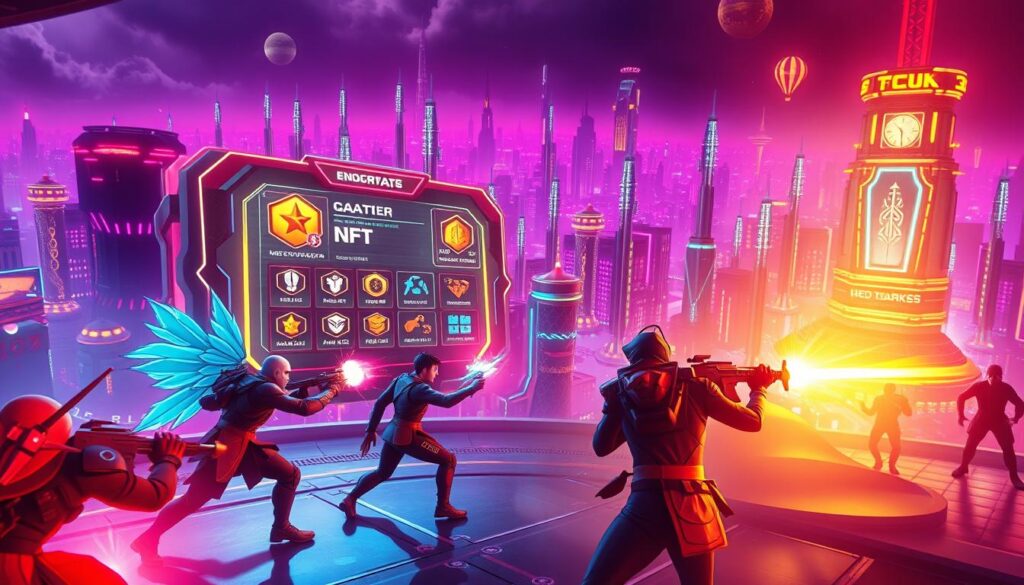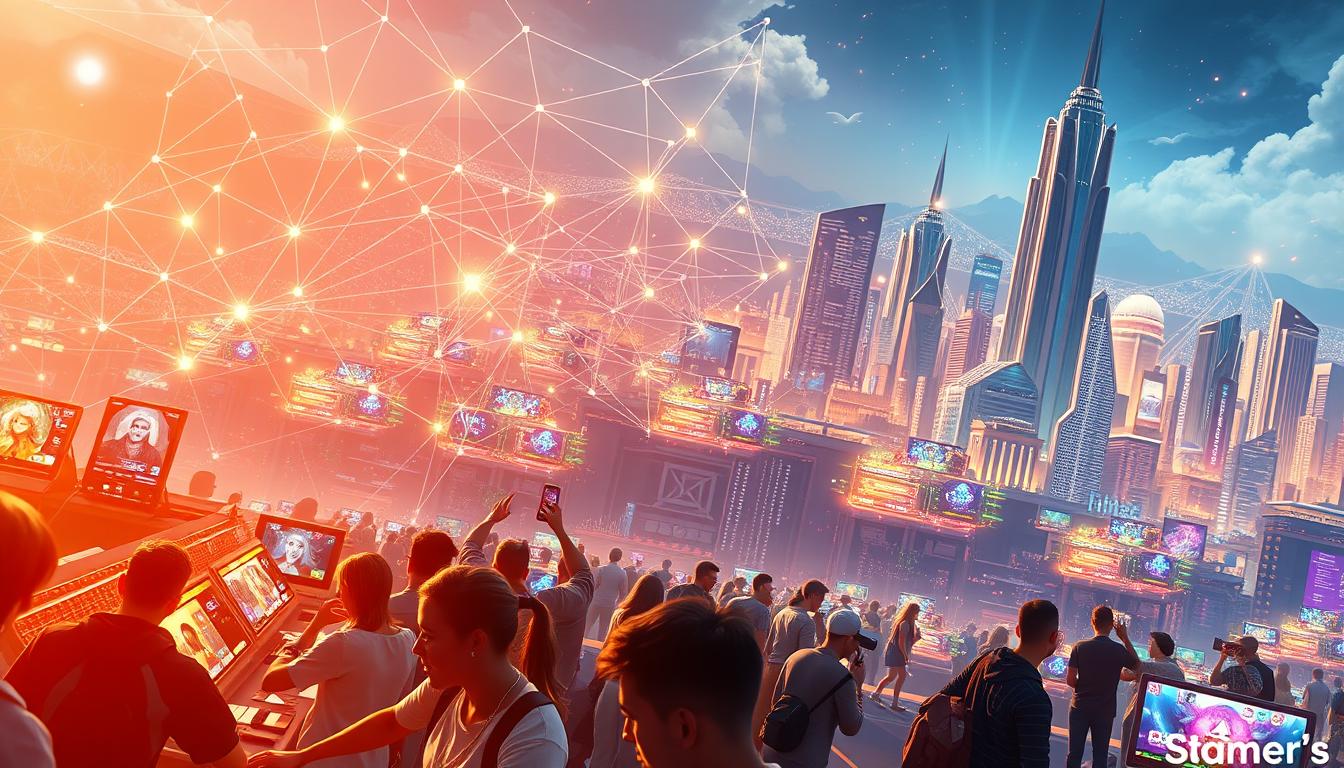Now Reading: Discover Play to Earn NFT Games with Real Rewards
- 01
Discover Play to Earn NFT Games with Real Rewards
Discover Play to Earn NFT Games with Real Rewards

Blockchain technology is reshaping how people interact with digital worlds. A new generation of crypto-powered titles lets users earn valuable assets while enjoying immersive experiences. Unlike conventional platforms, these systems let participants truly own their in-game items through decentralized networks.
At their core, these innovations blend entertainment with economic potential. Players complete challenges, trade virtual goods, or compete in tournaments to collect digital rewards. These assets – stored securely on chains like Ethereum or Solana – can be sold, traded, or held as investments.
The rise of decentralized gaming reflects broader shifts in digital ownership. Modern platforms empower users through transparent transaction records and peer-to-peer marketplaces. This approach contrasts sharply with traditional models where progress and items vanish when servers shut down.
Key Takeaways
- Blockchain gaming creates tangible value through tradable digital assets
- Major networks like Ethereum and Solana support secure ownership systems
- Skill-based activities generate crypto tokens and collectible items
- Decentralized platforms enable permanent asset control
- Global participation drives new economic opportunities
Introduction to the Crypto Gaming Landscape
The digital entertainment industry now thrives on player-driven economies. Modern platforms let users claim actual value from their achievements through blockchain-backed systems. This shift redefines how virtual interactions translate into tangible benefits.
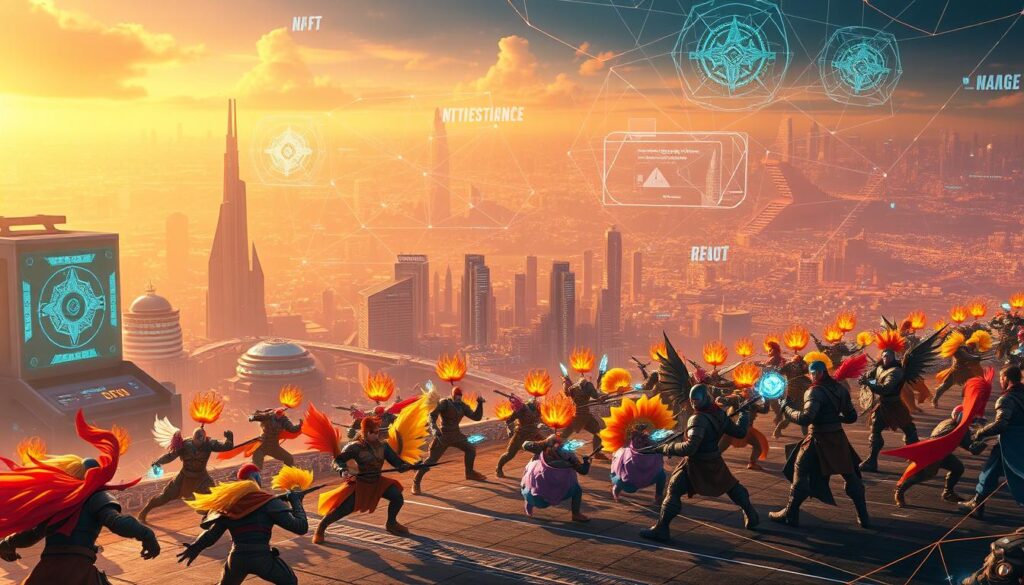
Digital Ownership and Blockchain Innovation
Blockchain’s core strength lies in granting indisputable ownership of digital items. Unlike traditional gaming accounts, decentralized ledgers permanently record asset transactions. Players now control rare skins, character upgrades, or digital collectibles as personal property.
Major platforms use smart contracts to automate rewards distribution. These self-executing agreements ensure fair compensation for in-game accomplishments. Such transparency builds trust across global player communities.
Market Trends in Gaming and NFTs
The crypto games sector saw 300% growth in active wallets since 2022. Virtual land parcels now sell for six figures on Ethereum-based platforms. Analysts predict the blockchain gaming market will reach $65 billion by 2027.
Three key drivers fuel this expansion:
- Cross-platform asset portability
- Player-controlled marketplaces
- Skill-based revenue streams
Developers increasingly blend classic gameplay with decentralized finance mechanics. This fusion creates sustainable ecosystems where time and strategy yield measurable returns.
Key Elements of NFT and Crypto Gaming
Modern interactive experiences now feature unique components that redefine player engagement. At their foundation lie two revolutionary concepts: verifiable ownership and automated systems that power digital economies.
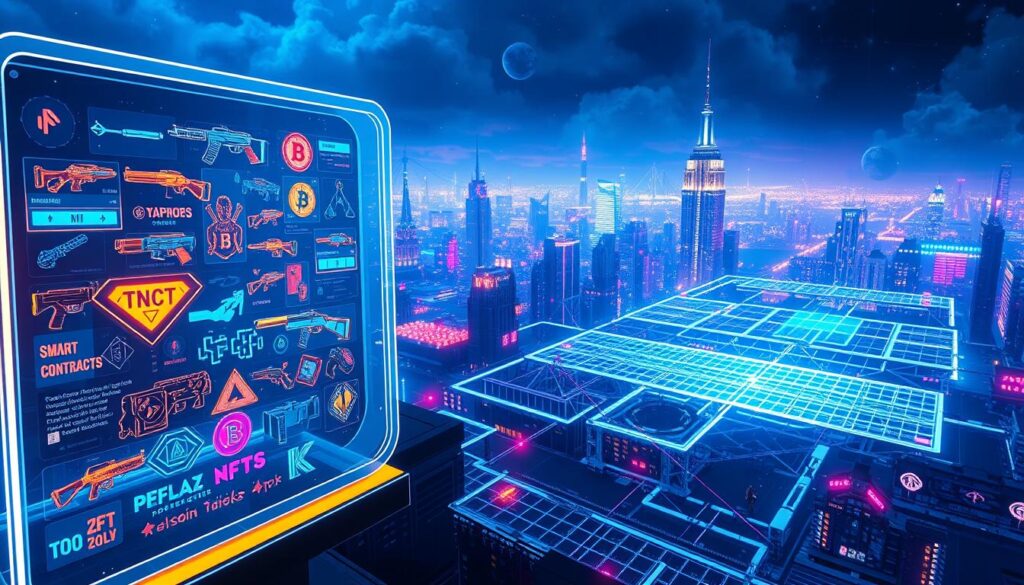
Understanding In-Game Assets and Smart Contracts
Digital collectibles form the backbone of crypto-powered experiences. These items range from battle-ready gear to virtual real estate, each carrying distinct traits that influence utility and value. Unlike traditional gaming loot, their ownership remains permanently recorded on blockchain ledgers.
Three factors determine an asset’s market price:
- Scarcity levels within the ecosystem
- Performance-enhancing attributes
- Demand within player marketplaces
Smart contracts automate critical processes without human oversight. These self-executing agreements handle tasks like reward distribution and item transfers. When you acquire a rare sword or trade land parcels, these digital protocols validate every transaction instantly.
Platforms typically offer multiple entry points for newcomers. Some provide basic starter kits at no cost, while premium options require marketplace purchases. Native tokens often serve as currency for acquiring high-value tools that boost competitive advantages.
The combination of programmable systems and player-owned economies creates transparent environments. Users retain full control over their digital possessions, whether battling opponents or trading collectibles across platforms.
Understanding Play to Earn NFT Games with Real Rewards
Digital environments now enable participants to generate consistent value through structured engagement models. These systems transform time and effort into measurable outcomes, blending entertainment with practical economics.
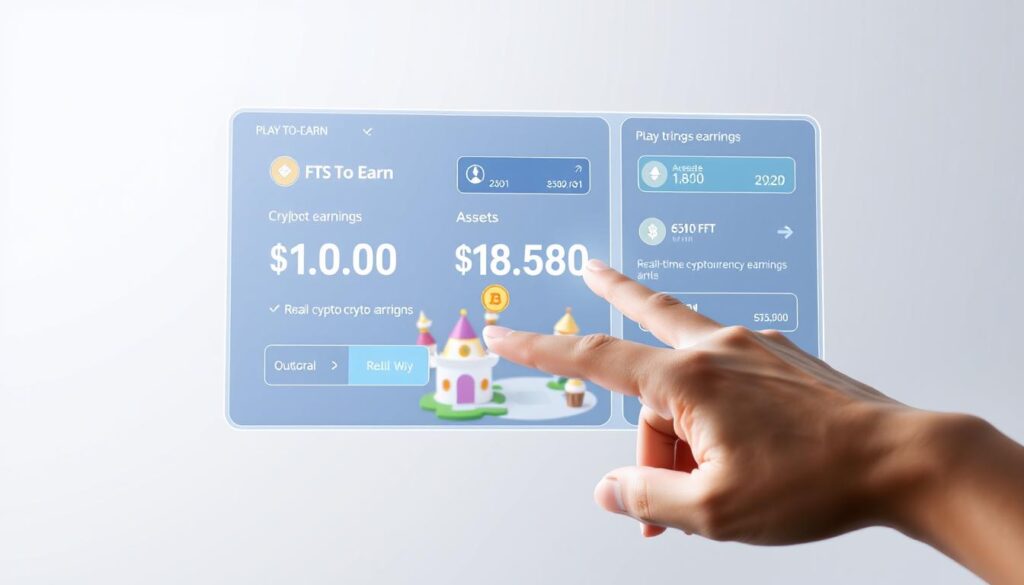
The Mechanics Behind Daily Earnings
Core activities drive value creation in blockchain-powered ecosystems. Completing story-driven missions, battling opponents, and joining timed events rank among popular methods. Success in these tasks often translates to tradable assets or governance influence.
Reward distribution varies across platforms. Skill-focused titles allocate prizes based on leaderboard rankings or match outcomes. Community-oriented versions distribute pooled resources equally among contributors. This flexibility allows users to match their risk tolerance and expertise.
| Activity Type | Reward Structure | Risk Level |
|---|---|---|
| Quest Completion | Fixed token amounts | Low |
| PvP Battles | Skill-based payouts | Medium |
| Tournaments | Percentage of prize pools | High |
| Staking | Passive token yields | Variable |
Advanced strategies involve locking digital assets to generate passive income. This process often grants decision-making power in platform development choices. Permanent ledger entries track all transactions, ensuring transparent ownership histories.
Daily returns depend on multiple factors. Initial investments, session duration, and competitive abilities all influence outcomes. Some participants focus on steady small gains, while others pursue high-stakes competitions for larger payouts.
Strategic approaches maximize earning potential across different titles. Combining collaborative tasks with skill-based competitions often yields optimal results. Regular participants typically develop personalized methods aligned with their strengths and schedules.
Differentiating Free-to-Play and Play-to-Earn Models
Players today face a choice between accessible entry and profit potential in blockchain-powered entertainment. These contrasting approaches shape how users interact with virtual worlds and monetize their efforts.

Comparing Rewards and Entry Costs
Free-access titles let users explore basic features without financial commitment. While ideal for casual engagement, these platforms rarely offer meaningful asset ownership. Limited-time events might provide small crypto bonuses, but substantial returns usually require upgrades.
Investment-driven models demand initial purchases of digital tools or characters. Three factors determine success in these ecosystems:
- Quality of acquired starter assets
- Time invested in skill development
- Market demand for earned items
Hybrid systems bridge these approaches through tiered participation. Some platforms offer free trial characters that can evolve into tradeable assets through achievements. This structure allows gradual progression from casual play to professional engagement.
| Model Type | Upfront Cost | Earning Potential |
|---|---|---|
| Free Access | $0 | Low |
| Hybrid | $10-$50 | Medium |
| Premium | $100+ | High |
Strategic selection depends on personal goals and risk tolerance. Casual enthusiasts often prefer no-cost options, while dedicated participants frequently justify initial investments through marketplace returns. Regular players should monitor asset liquidity and platform stability when choosing systems.
How Blockchain Technology is Revolutionizing Gameplay
Digital trust systems are rewriting the rules of virtual engagement. Blockchain’s decentralized architecture enables new forms of value exchange, letting users interact without relying on centralized authorities. This shift creates ecosystems where contributions directly translate into ownership rights.
Decentralized Economies and Trustless Transactions
Modern platforms eliminate middlemen through automated smart contracts. These systems handle asset transfers instantly, with transaction records permanently stored across distributed networks. Players trade digital collectibles peer-to-peer using decentralized marketplaces, retaining full control over their holdings.
Three core benefits define these systems:
- Transparent pricing through real-time supply/demand data
- Reduced fraud risks via immutable ownership logs
- Global liquidity pools for rare items
| Traditional Model | Blockchain Model |
|---|---|
| Centralized item storage | Wallet-based ownership |
| Limited trading options | Cross-platform asset transfers |
| Developer-controlled markets | Player-driven pricing |
Interoperability Across Game Platforms
Digital items now function as portable assets rather than locked content. A sword earned in one universe might serve as land decor in another, thanks to standardized token formats. This fluidity increases item utility and long-term value retention.
Major ecosystems use shared protocols allowing seamless asset migration. Explore popular Web3 gaming tokens that power these cross-platform economies. Players build unified inventories that work across multiple titles, creating persistent value streams.
Exploring In-Game Currencies and NFT Trading
Virtual economies now operate like real-world markets through specialized tokens and digital collectibles. These systems power character upgrades, item purchases, and access to premium content across interactive platforms.
- Utility tokens for gear enhancements and mystery box unlocks
- Governance tokens granting voting rights in platform decisions
- Reward tokens earned through quests and competitions
Many platforms let users convert virtual earnings into real value. Certain tokens trade on major crypto exchanges, creating financial bridges between digital worlds and traditional markets. This flexibility attracts both casual players and professional traders.
Digital collectibles gain value through specific traits:
- Rarity levels within their ecosystem
- Cross-platform compatibility features
- Practical in-game advantages
Market dynamics vary between native platforms and external venues. Built-in marketplaces often offer better liquidity for common items, while specialized exchanges handle rare assets. Discover how these systems work within blockchain gaming ecosystems through hands-on exploration.
Successful trading strategies balance short-term opportunities with long-term value tracking. Regular participants monitor supply trends and platform updates to maximize returns. This approach turns recreational activities into viable economic engagements.
The Role of Smart Contracts in Secure Gaming
Digital ecosystems now rely on self-executing protocols to redefine asset security. These automated systems validate every exchange, ensuring participants interact with verified items and users. This foundation transforms how virtual economies handle high-value transactions.
Building Trust Through Automated Systems
Smart contracts act as digital referees, scanning ownership history and item authenticity before processing trades. Unlike traditional methods, this verification happens instantly across decentralized networks. Players gain confidence knowing their digital collectibles can’t be copied or stolen mid-transaction.
Three layers of protection emerge in these systems:
- Real-time fraud detection during asset transfers
- Permanent ownership records resistant to manipulation
- Automated dispute resolution through predefined rules
Platforms using smart contract implementations eliminate third-party risks. Transactions complete directly between user wallets, cutting processing fees by up to 70%. This efficiency attracts both casual traders and professional collectors.
Emergency protocols within these systems automatically freeze suspicious activities. Multi-signature approvals add extra security for high-value exchanges. Such features create environments where digital assets maintain real-world value through protected ownership rights.


